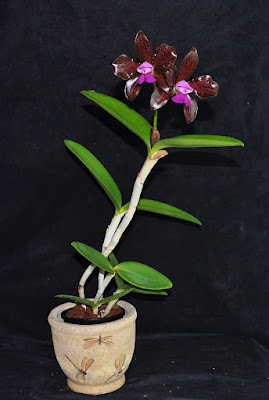Cattleya tigrina - Tiger Striped Cattleya flowers are sweety fragrant. Sepals and petals are fleshy, brown, usually spotted. Lip whitish pink and...
Cattleya tigrina, also called as Tiger Striped Cattleya, Cattleya guttata subvar. immaculata, Cattleya guttata var. leopardina, Cattleya guttata var. leopoldii, Cattleya guttata var. williamsiana, Cattleya leopoldii, Cattleya leopoldii var. alba, Cattleya leopoldii f. alba, Cattleya leopoldii f. caerulea, Cattleya leopoldii f. immaculata, Cattleya leopoldii var. immaculata, Cattleya leopoldii var. leopardina, Cattleya leopoldii var. williamsiana, Cattleya tigrina f. alba, Cattleya tigrina var. caerulea, Cattleya tigrina var. immaculata, Cattleya tigrina var. leopardina, Cattleya tigrina f. pelorica, Cattleya tigrina var. purpurea, Cattleya tigrina var. williamsiana, Epidendrum elatius var. leopoldii, Epidendrum elegans, is a species of the genus Cattleya. This species was described by Achille Richard in 1848.
DESCRIPTION OF CATTLEYA TIGRINA - TIGER STRIPED CATTLEYA
Cattleya tigrina is native to Eastern and Southern Brazil. It is found growing on trees and shrubs near coastal sand dunes in coastal forests from the south of Bahia to Rio Grande do Sul at elevations of below 100 meters above sea level.
It is a large, bifoliate to trifoliate, warm growing epiphyte which reaching 30-80 cm in height with cylindrical, slightly thickened apically, 17.5-63 cm long pseudobulbs that are covered with paleaceous white sheaths. The leaves are 2-3, 5.1-27.9 x 2.2-7.6 cm, semi-erect, concave to slightly flat, leathery, elliptical-lanceolate, apex acute, base amplexicaule, margin entire.
Tiger Striped Cattleya blooms in mid-summer from the erect, 3 to 17 flowered racemose inflorescence that is subtended by a green sheath on a newly arising pseudobulb. The flowers are 7-11 cm in diameter, sweety fragrant. Sepals and petals are fleshy, brown, usually spotted. Lip conspicuously trilobed, with terminal lobe divided into two lobes, whitish pink lateral lobes and magenta terminal lobes.
CATTLEYA TIGRINA - TIGER STRIPED CATTLEYA CARE AND CULTURE
Cultural information should only be used as a guide, and should be to be adapted to suit you. Your physical location; where you grow your plants, how much time you have to devote to their care, and many other factors, will need to be taken into account. Only then can you decide on the cultural methods that best suit you and your plants.
Light:
Cattleya tigrina needs a light level of 25000-35000 lux. Strong air movement should be ensured all the time, especially during flowering. In winter the light level should be the highest. If plants were previously grown in shadier conditions, the light level should be increased gradually. Rapid change can lead to very serious damage to the plant, and even to complete destruction by the sun. During growth periods, the leaves should have a medium green colour as this will indicate correct light levels.
Temperature:
In summer, the average day temperature is 27-29 °C, and the average night temperature is 21-23 °C, with a daily amplitude of 6-8 ° C. In winter, the average day temperature is 25-26 °C, and the average night temperature is 18-20 °C, with a daily amplitude of 6-8 ° C.
Humidity:
Tiger Striped Cattleya needs the average humidity of 70-80% for most of the year, drop to 50-60% in winter. A light misting can be applied at morning and night to help to provide humidity if required when watering is not taking place. The plant like higher night time humidity, with lower daytime levels. Attention must be paid that too high humidity will spoil the flowers.
Substrate, growing media and repotting:
Cattleya tigrina are usually grown in pots or baskets filled with a very thick, loose, quick-drying medium that allows the roots to dry quickly after watering. Rather smaller pots sufficient for 1-2 years of growth are recommended, because the substrate in larger pots remains wet after watering for too long. Rotting may be the result of insufficiently quick drying of the roots. Most growers recommend thick bark, though others prefer pieces of cork mixed with large lumps of charcoal.
Repotting or dividing the plants should be done only when the growth of new roots begins. This will allow the plant to take root in the shortest possible time and avoid weakness. If violated at the wrong time, many plant will stagnate and eventually perish. For the first few weeks after re-potting plants should be keep dryer than usual to help protect the roots, the exception is if there are new live root tips, the plant must be grown as normal. A light misting can be applied after re-potting to help the plants along. Broken roots will rot in the pot, so preventive trimming of any broken roots are strongly recommended.
The plant can also grow well mounted on rootstocks made of cork, tree fern or uneven bark, with high humidity ensured and watering at least once a day in the growing season. In the summer during hot, dry weather, it may be necessary to water several times a day.
Watering:
Tiger Striped Cattleya should be abundantly watered during active growth, but the roots must always dry quickly after watering. This can easily be seen, especially in clear pots by checking the root colour. Greenish or slightly translucent means the roots are still wet, and white roots are dry. When new growths reach maturity in the autumn, the amount of water should be reduced. The flower buds are susceptible to fungal infections if the plant is kept too wet before flowering.
Fertilizer:
The plants should be fertilized every week 1/4-1/2 of the recommended dose of fertilizer for orchids. A fertilizer with a high nitrogen content is beneficial from spring to mid-summer, and a fertilizer richer in phosphorus should be used in late summer and autumn.
Rest period:
Cattleya tigrina should be given a drier rest as new growths mature. In winter, when not in active growth, the plant need less water but should not be dry for long periods. Fertilization should be reduced until watering is increased in spring, especially for plants grown in the darker, short-day conditions typical of higher latitudes.















COMMENTS